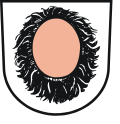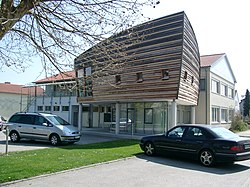|
Pfaffenhofen, Baden-Württemberg
Pfaffenhofen (German: [pfafn̩ˈhoːfn̩] ⓘ) is a municipality in the district of Heilbronn in Baden-Württemberg in Germany. GeographyPfaffenhofen is situated on the Zaber in the Zabergäu in the southwest of the district of Heilbronn. Neighbouring municipalitiesNeighbouring towns and municipalities of Pfaffenhofen are (clockwise from the west): Zaberfeld, Eppingen, Güglingen (all of the district of Heilbronn) and Sachsenheim (district of Ludwigsburg). Pfaffenhofen has combined with Güglingen and Zaberfeld to form a joint association of administrations called Oberes Zabergäu. Municipal structureApart from the main village of Pfaffenhofen there's the municipal part Weiler an der Zaber. The hamlet Rodbachhof also belongs to Pfaffenhofen. The village Rodenbach which doesn't exist anymore was situated on the communal land of Pfaffenhofen.[3] HistoryPfaffenhofen was presumably founded in times of the Christianization of Germany. It was first mentioned documentary as Pfaffenhoven on May 30, 1279. Already before 1380 Burkhard von Hohenberg sold the half of the village to Württemberg, in 1380 the other half followed. Weiler an der Zaber presumably already existed around 1000. It was first mentioned documentary on June 15, 1279. In the 14th century the village came to Württemberg. On January 1, 1972, Weiler an der Zaber was incorporated to Pfaffenhofen. ReligionsPfaffenhofen previously belonged to the Speyer Bishopric. By the introduction of the reformation in Württemberg it got Protestant. The municipality is still shaped Protestant today, so in Pfaffenhofen and Weiler an der Zaber there's a Protestant parish in each village. The Catholic parish Holy Trinity Güglingen is responsible for Pfaffenhofen's Catholic citizens. Development of population
(each date of January 1) PoliticsDistrict councilThe district council of Pfaffenhofen has 12 seats, 8 of Pfaffenhofen and 4 of Weiler. By the communal election of June 13, 2004, it has 13 seats due to an overhang seat. The mayor is also a member of the district council and its chairman. Arms and flag Blazon: In silver a priest's tonsure proper. The municipal colours are red and white. The oldest known seal of Pfaffenhofen proved from 1482 to 1611 shows a human figure behind a fence: a talking arms, a priest (cleric) in a yard. Coloured portrayals of this arms are derived since 1535. A seal of 1678 showed two straightened up lions holding a disc. At least in the 20th century the tonsure developed into a sun with face by misunderstandings. In 1956 the municipality took a priest tonsure as its arms again by suggestion of the archive directory. The arms was confirmed by the ministry of the interior on November 13, 1956, the flag was given by the district of Heilbronn on January 31, 1980.[4] Culture and sights Notable buildings
Economy and infrastructureBigger local factories are Lang-Verpackungen and Betonwerk Volland GmbH with 70 employees each one.  TrafficConnections to the long-distance network exist in Lauffen am Neckar and Kirchheim am Neckar (B 27). Public transport in the PTE H3NV is ensured by buses. Connections to the rail network are also in Lauffen am Neckar und Kirchheim am Neckar (Frankenbahn). The laid up Zabergäubahn (Lauffen am Neckar–Leonbronn) has stations in Pfaffenhofen and Weiler. The rail route shall be a part of the stadtbahn network Heilbronn until 2011. However, in July 2006 a report appeared making this doubtful.[5] MediaAbout happenings in Pfaffenhofen the Heilbronner Stimme reports in its south-west edition. EducationPfaffenhofen has a primary school at its disposal. References
External links
|
||||||||||||||||||||||||||||||||||||||||||||||||||||||||









